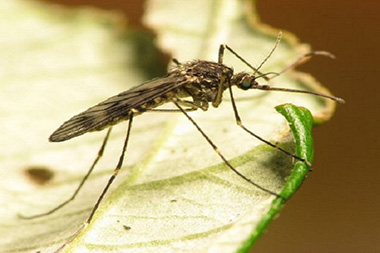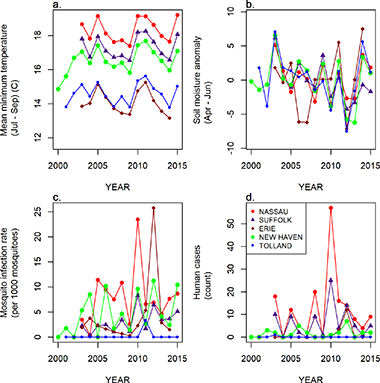Improving the Prediction of Vector-Borne Diseases
 |
|
UAlbany, NYSDOH scientists are using statistics to fight back against the West Nile virus.
|
ALBANY, N.Y. (Aug. 29, 2019) – A large group of scientists affiliated with UAlbany, the New York State Department of Health (NYSDOH) and Connecticut Agricultural Experimental Station are taking a first step towards better understanding patterns of West Nile virus (WNV) activity in the Northeast United States.
The scientists, all part of the Climate Change and Emerging Infectious Disease (CCEID) working group, have published a new paper that analyzes the impact of various climate variations on WNV infection rates for both mosquitoes and humans in New York and Connecticut.
Using a machine-based statistic model called “Random Forests,” the CCEID scientists tested 66 climate-related variables based on temperature, precipitation and soil moisture, aggregated by county and individual mosquito trap locations. Another about 20 non-climatic variables were also included to account for relevant factors such as the region’s human population, mosquito abundance and presence of wastewater treatment plants.
According to the group, temperature, rainfall, soil wetness and other climatic factors are known to have a direct impact on mosquito populations and infection rates. By creating a proven statistical model, they hope to be able to provide seasonal forecasts for WNV and identify counties or locations with increased risk for the disease.
Their results indicate that low soil moisture and/or warm summer nights are associated with increased numbers of human cases. This is consistent with previous research that has shown most human cases of WNV are contracted during the summer, from July to September.
The group’s findings were published in PLOS ONE.
 |
|
Study graphic: Mean minimum temperature (a), soil moisture anomaly (b), mosquito infection rate (c), and human case counts (d) by year for five example counties.
|
“This research is a step towards understanding the pattern of West Nile virus activity in New York and Connecticut. It provides a baseline for our group for future analyses that will allow us to better predict years of high West Nile virus activity,” said Alexander ‘Sasha’ Keyel, the paper’s lead author, and a post-doctoral researcher in the Department of Atmospheric and Environmental Sciences (DAES) and NYSDOH Wadsworth Center.
“The next steps will be to look at improving the statistical model, comparing the model to other forecast models, and using the best model to estimate how WNV conditions will evolve under future climate change in the Northeast,” he added.
With seed funding from UAlbany’s Division for Research, UAlbany’s DAES and School of Public Health partnered with the Wadsworth Center to form the CCEID working group in 2015. Together, the group has collaborated to better understand how environmental factors increase or decrease human health risk from vector-borne pathogens and to analyze the spatial and temporal variations of WNV infections.
Last June, the group joined seven other universities, as well as other state health departments, to create the $10 million Northeast Regional Center for Excellence in Vector-Borne Diseases (NEVBD) at Cornell University, one of only five such regional centers in the country. Now, as part of the NEVBD project, CCEID aims to develop statistical models that can be used as new predictive tools.
Diseases caused by tick, mosquito and fleabites more than tripled in the U.S. between 2004 and 2016, according to a recent CDC report.
“Prediction of vector-borne diseases is challenging due to its complexity. On one hand, there are the physical climate processes acting across wide geographic regions, and on the other end are biological processes that locally control the infectiousness of the mosquitoes. Forecasting human cases adds another layer of complexity,” said Oliver Elison Timm, a DAES associate professor and study co-author.
“At present we are not ready to provide seasonal forecasts. The results of our research, however, have the potential to eventually reduce the human risks involved with WNV,” he added.
Those interested in learning more about WNV and other vector-borne diseases can visit the NYSDOH’s FAQ page. More information about the NEVBD including a full list of collaborators can be found here.
![]() For more news, subscribe to UAlbany's RSS headline feeds
For more news, subscribe to UAlbany's RSS headline feeds
A comprehensive public research university, the University at Albany-SUNY offers more than 120 undergraduate majors and minors and 125 master's, doctoral and graduate certificate programs. UAlbany is a leader among all New York State colleges and universities in such diverse fields as atmospheric and environmental sciences, business, education, public health,health sciences, criminal justice, emergency preparedness, engineering and applied sciences, informatics, public administration, social welfare and sociology, taught by an extensive roster of faculty experts. It also offers expanded academic and research opportunities for students through an affiliation with Albany Law School. With a curriculum enhanced by 600 study-abroad opportunities, UAlbany launches great careers.


